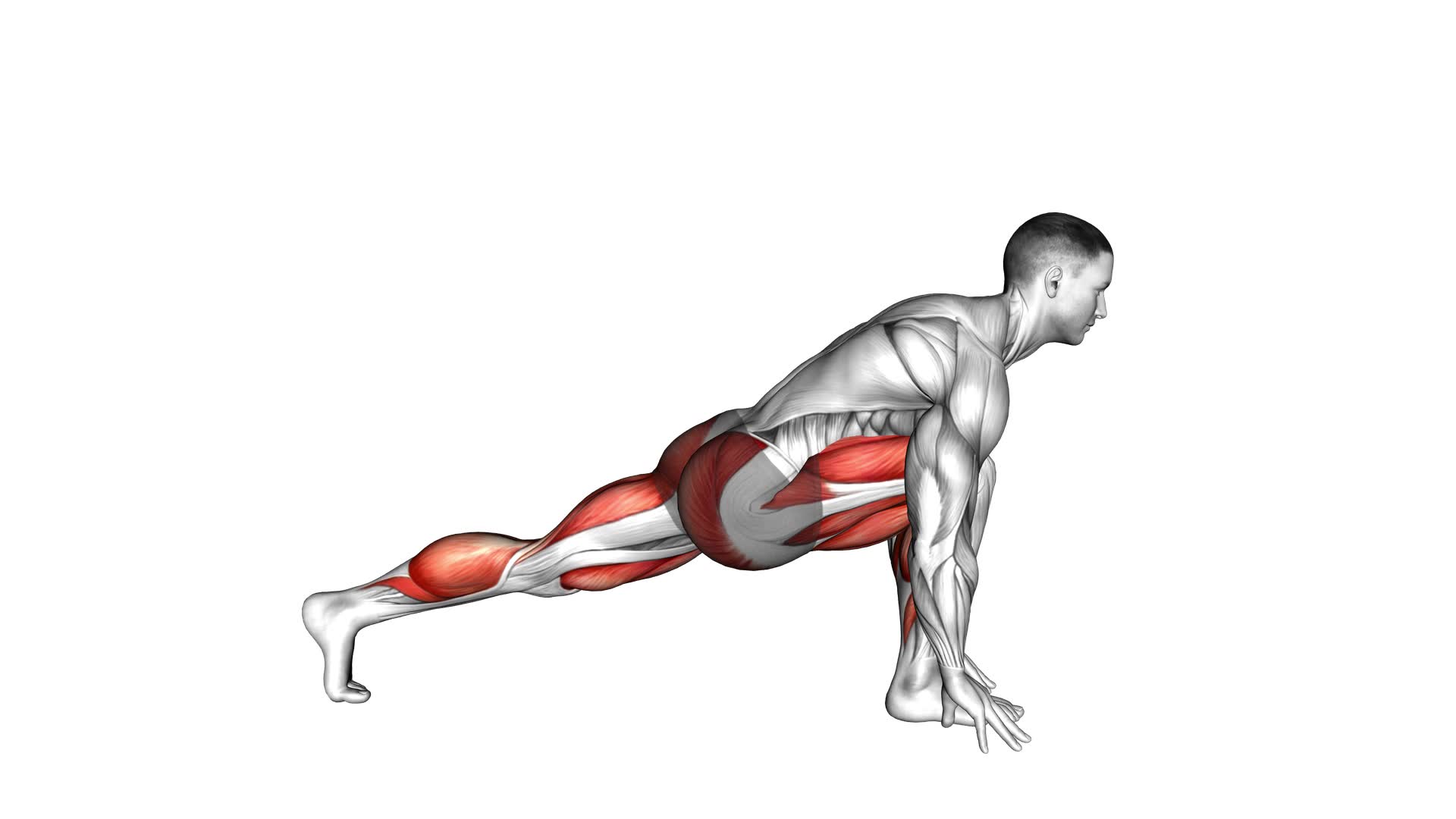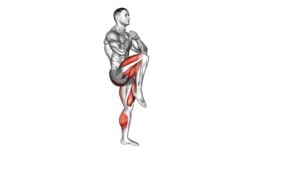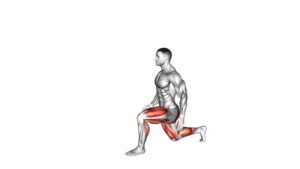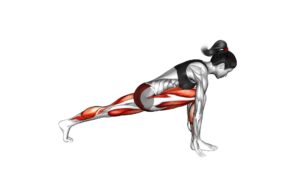High Lunge (male) – Video Exercise Guide & Tips

Get ready to strengthen your lower body and improve your flexibility with the high lunge (male). In this video exercise guide, you'll find expert tips and proper form techniques to maximize your results.
Watch This Exercise Video
Whether you're a beginner or an advanced fitness enthusiast, we've got modifications for every fitness level. Avoid common mistakes and increase the intensity of your workout with our helpful tips.
It's time to take your lunges to the next level!
Key Takeaways
- High Lunge targets quadriceps, hamstrings, and glutes, building strength and endurance in the legs.
- It improves hip flexibility and opens up the hips.
- Modifications and variations like Crescent Lunge and Warrior I pose can be incorporated for advanced practitioners.
- Proper form is crucial, including keeping the front knee directly above the ankle and maintaining a straight and strong rear leg.
Benefits of High Lunge (male)
What are the benefits of performing the High Lunge (male) exercise?
The High Lunge (male) offers a range of benefits for your body and overall fitness. This exercise primarily targets the lower body, specifically the quadriceps, hamstrings, and glutes. By engaging these muscle groups, the High Lunge helps to build strength, stability, and endurance in your legs. Additionally, this exercise improves hip flexibility and opens up the hips, which can be particularly beneficial for individuals who spend a lot of time sitting or have tight hip muscles.
Furthermore, the High Lunge (male) can be modified and progressed to suit advanced practitioners. One variation is the Crescent Lunge, where you lift your back heel off the ground and bring your arms up overhead. This variation intensifies the stretch in the hip flexors and challenges your balance and core stability. Another variation is the Warrior I pose, where you rotate your torso to face the front and bring your arms up towards the ceiling. This variation further strengthens the legs and engages the upper body.
Now that we've explored the benefits of the High Lunge (male), let's move on to discussing proper form and technique for this exercise.
Proper Form and Technique
To perform the High Lunge (male) exercise with proper form and technique, you should begin by standing with your feet hip-width apart. Step one foot forward, keeping a slight bend in both knees. The back foot should remain planted on the ground, with the heel lifted. Engage your core and maintain an upright posture throughout the exercise.
One common misconception is that the front knee should extend past the toes. However, it's important to keep the front knee directly above the ankle to prevent strain on the joints. Another misconception is that the back knee should touch the ground. While some variations of the High Lunge may require the back knee to touch, in the basic version, the back knee remains lifted.
There are variations and alternatives to the High Lunge (male) exercise that you can incorporate into your routine. One option is the Reverse Lunge, where you step the foot backward instead of forward. This variation targets the glutes and hamstrings more intensely. Another alternative is the Crescent Lunge, where you raise your arms overhead while in the lunge position, adding an upper body element to the exercise.
Remember to always listen to your body and adjust the exercise as needed. Focus on maintaining proper form and technique to ensure a safe and effective workout.
Modifications for Different Fitness Levels
Choose the appropriate modification level for your fitness by considering your abilities and goals. When it comes to the high lunge exercise, there are various progression options and modifications available to accommodate different fitness levels.
If you're a beginner or have limited mobility, you can start with a shallow lunge by not bending your front knee as deeply. This will help you build strength and stability gradually. As you become more comfortable, you can increase the depth of your lunge and work towards a deeper stretch.
For those looking for a challenge, you can try adding weights or resistance bands to increase the intensity of the exercise. This will engage your muscles even more and help you build strength and endurance. Additionally, you can incorporate balance exercises by lifting your back leg off the ground or adding a twist to the exercise.
If you have any injuries or physical limitations, it's important to modify the high lunge to avoid exacerbating the condition. For example, if you have knee pain, you can perform a low lunge by keeping your back knee on the ground. This will still engage your leg muscles while reducing stress on the knee joint.
Remember to always listen to your body and consult with a fitness professional or healthcare provider for personalized modifications and recommendations.
Common Mistakes to Avoid
To avoid common mistakes, always regularly assess your form and make necessary adjustments while performing the high lunge exercise. Proper alignment is crucial to prevent injuries and maximize the effectiveness of this exercise.
One common mistake is allowing the front knee to extend beyond the toes. To avoid this, make sure to keep your front knee directly above your ankle, creating a 90-degree angle.
Another mistake is collapsing the chest and rounding the back. Instead, engage your core and lift your chest, maintaining a tall posture.
Additionally, avoid leaning too far forward or backward. Find a balance where your torso is upright and aligned with your hips.
Lastly, be mindful of your rear leg. Keep it straight and strong, ensuring that your back foot is pointing forward.
By following these alignment tips and making necessary adjustments, you can perform the high lunge exercise safely and effectively.
Now that you have learned how to avoid common mistakes, let's move on to tips for increasing the intensity of the high lunge exercise.
Tips for Increasing Intensity
To increase the intensity of the high lunge exercise, try incorporating dynamic arm movements for added challenge and engagement. By incorporating arm movements, you not only work your lower body but also engage your upper body, making the exercise more challenging and effective. As you step forward into the lunge, raise your arms overhead, and then lower them back down as you step back into the starting position. This movement adds resistance and increases the difficulty of the exercise.
Another way to increase the difficulty of the high lunge is by adding weights. Holding dumbbells or kettlebells in your hands while performing the exercise adds extra resistance, making your muscles work harder. Start with lighter weights and gradually increase as you get stronger and more comfortable with the exercise.
For those looking for advanced variations of the high lunge, try incorporating a twist or a knee drive. As you step forward into the lunge, twist your torso towards the front leg, engaging your obliques and challenging your balance. Alternatively, you can drive your back knee up towards your chest while in the lunge position, engaging your core and working your hip flexors.
Remember to always listen to your body and start with modifications or lighter weights if needed. It's important to gradually increase the intensity to avoid injury and ensure proper form.
Frequently Asked Questions
How Often Should I Perform High Lunge (Male) Exercises?
To get the most out of your high lunge exercises, it's important to find a frequency that works for you. Lunge variations, like the high lunge, are great for strengthening your legs, improving balance, and increasing flexibility.
As a general guideline, aim to incorporate high lunges into your workout routine at least 2-3 times a week. However, listen to your body and adjust accordingly. Remember, consistency is key for reaping the benefits of high lunge.
Can High Lunge (Male) Help With Reducing Lower Back Pain?
High Lunge (male) is a beneficial exercise that can improve flexibility. It can also help reduce lower back pain by stretching and strengthening the muscles in your legs, hips, and core.
However, if you have knee pain, it's important to be cautious when performing this exercise. Listen to your body and modify the movement if needed to avoid aggravating your knees.
Always consult a healthcare professional if you have any concerns or questions about incorporating High Lunge into your fitness routine.
Are There Any Specific Breathing Techniques to Follow During High Lunge (Male)?
During high lunge (male), it's important to focus on your breathing. By taking deep breaths in and out, you can help maintain balance and stability in the pose.
Inhale as you reach your arms up and exhale as you sink deeper into the lunge. This will help you stay present and connected to your body throughout the exercise.
For beginners, modifications can be made by using blocks or lowering the back knee for added support.
Should I Warm up Before Performing High Lunge (Male)?
Before performing high lunge, it's important to warm up your body. Preparation exercises can help loosen your muscles and increase your range of motion, reducing the risk of injury.
Warming up also improves blood circulation, allowing your muscles to work more efficiently during the exercise. By incorporating a warm-up routine into your workout, you can optimize your performance and get the most out of your high lunge exercise.
Can High Lunge (Male) Help Improve Balance and Stability?
High lunge (male) is a great exercise for improving balance and stability. By incorporating this pose into your workout routine, you can enhance your flexibility and strengthen the muscles in your legs, hips, and core.
Athletes can benefit from high lunge as it helps to improve their overall stability and control during sports activities.
Conclusion
In conclusion, the high lunge exercise is a great way for men to improve their fitness levels. By maintaining proper form and technique, you can maximize the benefits of this exercise.
Remember to modify the intensity based on your fitness level and avoid common mistakes. With these tips in mind, you can increase the intensity of your high lunge and achieve your fitness goals.

Author
Years ago, the spark of my life’s passion ignited in my mind the moment I stepped into the local gym for the first time. The inaugural bead of perspiration, the initial endeavor, the very first surge of endorphins, and a sense of pride that washed over me post-workout marked the beginning of my deep-seated interest in strength sports, fitness, and sports nutrition. This very curiosity blossomed rapidly into a profound fascination, propelling me to earn a Master’s degree in Physical Education from the Academy of Physical Education in Krakow, followed by a Sports Manager diploma from the Jagiellonian University. My journey of growth led me to gain more specialized qualifications, such as being a certified personal trainer with a focus on sports dietetics, a lifeguard, and an instructor for wellness and corrective gymnastics. Theoretical knowledge paired seamlessly with practical experience, reinforcing my belief that the transformation of individuals under my guidance was also a reflection of my personal growth. This belief holds true even today. Each day, I strive to push the boundaries and explore new realms. These realms gently elevate me to greater heights. The unique combination of passion for my field and the continuous quest for growth fuels my drive to break new ground.



